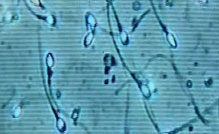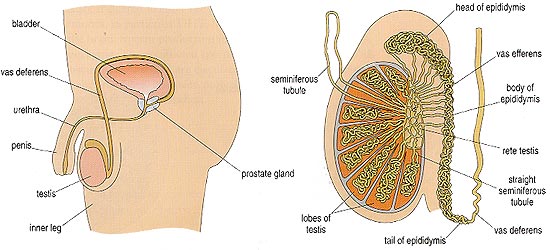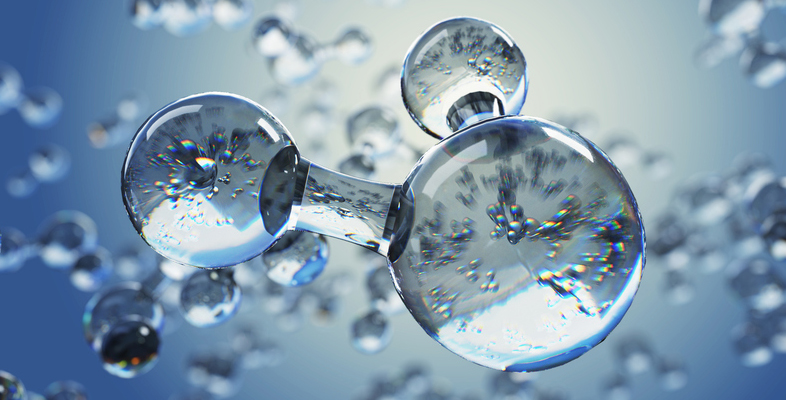Find out about The Open University's Biology courses and qualifications
THIS ARTICLE CONTAINS FRANK DISCUSSION OF SEXUAL AND REPRODUCTIVE SCIENCE

Although I'm a biologist, I rarely think much about what the cloudy white stuff contains, but in fact semen is far more complex than my endearing childhood image of mini tadpoles swimming around in thin wallpaper paste.
There are many features of human semen that are very familiar to most people, but their importance isn't appreciated. For a start, the ejaculate isn't of a uniform consistency. As the man ejaculates, the first 'spurt' contains far more sperm than subsequent spurts. This is why the withdrawal method of contraception is so dangerous. If the man is only a split second too late then the most potent portion of semen ends up exactly where he or his partner doesn't want it. In fact, it has been suggested that should the couple mistime things, they are best off not bothering to withdraw at all, but please don't try that one at home.
Sperm: the active ingredient
First, let's talk numbers. The quantity of sperm cells that men produce varies widely. In general, it is said that men may produce between two millilitres (2ml) and 5ml of semen each time they ejaculate, and that each millilitre may contain from 20 million to 300 million sperm cells. That means a fertile man may produce between 40 million and 1800 million sperm cells in total, though the majority produce between 40 and 60 million sperm cells per millilitre, giving an average total of 80 to 300 million sperm per ejaculation.
Before going ahead with this episode of Lab Rats, Zeron and I were checked out at our local hospitals and our sperm count calculated. Of course, had we known the results before filming, the programme would have been a farce, so the results were kept secret from us. Without the pressure of filming, the long hours, lack of privacy and tiredness, I produced about 300 million spermatozoa in 4ml of semen and Zeron pumped out over 80 million in nearly 3ml, so both of us were found to be perfectly fertile. This was cool, because neither of us would have wanted to find out that we were infertile, and because Zeron has kids it would have been a big worry for him had it been shown that he was! (After all, up to one in seven British children are not the genetic offspring of the man considered to be their father.)
But sperm count alone is not the only factor that determines fertility. To understand the biology behind male fertility it must first be understood how sperm are produced, how they are transported from the man, and then how they fight their way to their final prize - the egg that may be waiting for them at the end of the female genital tract. Just to think about it makes me feel guilty, because a rough calculation shows that I've disappointed about 7,500,000,000,000 of the little fellas.

Are all sperm cells similar?
The 'tail' of the human sperm is predictably used to propel them through liquids, the 'head' contains small energy factories called mitochondria, in addition to the cell's DNA - packaged into twenty three chromosomes. At the tip of the sperm's head is a package that contains enzymes that break down protective layers on the egg's surface.
Not all human sperm cells look the same. Some have two heads or no heads, some have huge heads, some have small tails or no tails, others may be bent at right angles, or have spiral tails. Many of the unusual ones are probably not fertile.
Spermatogenesis
Men aren't born with ready-made sperm cells - they have to be made later, from puberty onwards. (Interestingly, when females are born they already have all their quota of eggs.) Spermatozoa are made in vessels, within the testicles, called seminiferous tubules:
 The Male Reproductive Tract
The Male Reproductive Tract
Once produced, they begin to mature in the epididymis and the vas deferens. These tubes ultimately lead to the urethra - the tube through which we urinate. Men also use the urethra to deliver semen into the female reproductive tract. The whole process of production and maturation within the male body takes anything up to 74 days, but the usual average is around nine weeks.
One more interesting fact about spermatogenesis is that sperm cells prefer a cool environment. At puberty our testicles descend from our bodies and begin to hang between our legs. This helps maintain the temperature of our sperm-making machinery at two degrees below body temperature. This difference isn't unique to humans and is far less marked than in rams and bulls, whose testicles generally remain six to eight degrees below body temperature. However small the temperature differences may appear to be, they are crucial. Should both testicles be retained within the body after a man has gone through puberty then he would be infertile. If one testicle descended then there is a chance that the man may be fertile, but this isn't guaranteed. By wrapping my balls in hot padding, I did my best to reduce my sperm production.
Interesting fact
Although sperm are constantly being made within the testicles, should the man not ejaculate for some time, his testicles won't explode. The spermatozoa are simply re-absorbed into the body. This is important for vasectomy patients because they simply have their 'tubes cut' and sperm is still produced. Should excess sperm not be absorbed, it would not be long before the patient's testicles were dragging along the ground.
The number of sperm produced by a man is directly proportional to testicle volume. To measure our testicle size, Zeron and I had to make an alginate mould and then construct a 'sculpture' of our testes.
Considering the number of sperm produced, human testicles (testes) are considerably smaller, as a proportion of body weight, than some other animals, such as chimps. On average, human testes have a volume of 20 - 40ml with a weight of 10 - 15g, which is a few ten thousandths of our body weight. We found that Zeron's testicles had a volume of 30ml and 25ml and mine had a volume of 35ml and 30ml, so we both looked like we might pack a reasonable punch (it's not unusual for testicles to be of unequal volume).

A trying obstacle course
The best way of maximizing the chances of your sperm fertilizing an egg is to get them off to a flying start, and this means getting a good hard erection. Penile erection is the result of a complicated process of raised blood pressure and altered blood flow, and it can be influenced by a whole range of physical and emotional factors. Lifestyle is also important. If you're very tired or depressed, or have simply drunk too much alcohol, you may have trouble getting stiff. Embarrassment is a real turn-off too, as Zeron found while being filmed! Most men suffer at least a few episodes of erection failure during their lives. Usually it's nothing to worry about.
Once ejaculation has happened, how sperm find their way to the egg is not accurately known. The first thing to bear in mind is that the woman's vagina is not a dead end. There is an exit into the womb, called the cervix, that provides the way out. The channel that runs through the cervix is not empty; it is filled with mucus. Surprisingly, unlike the snot that comes from your nose when you have a cold, the mucus within the cervix is very complex. Because it is the last line of defence between the womb and the outside world, the mucus must provide protection against bacteria, but at the same time allow sperm to enter the womb and menstrual flow to find its way out. To accomplish this, the mucus contains thousands of fibres that help to make an intricate structure permeated by countless narrow channels. Sperm cells can make their way through the channels, but bacteria (which are far less motile) and viruses (which can't move at all) find this impossible. The chemical composition of the cervical mucus varies with the woman's cycle, affecting the ease with which sperm can penetrate it.
Spermatozoa which are healthy and take the right route are rare. Many take the wrong channel and never get near to their goal. To achieve fertilisation, a sperm must travel up the oviducts and then do far more than just run into an egg. This is because the egg arrives in the oviducts surrounded by a triplicate coat of armour. The sperm cells literally have to fight their way through the three layers, first using chemicals contained in their acrosome, and then using a spike on their head to puncture a hole as the sperm forces its way forward by thrashing its tail. Finally, should one sperm cell get this far and make contact with the egg membrane, it is engulfed and can then go about fertilisation: all other sperm cells reaching the egg are then repelled. This is because once a single sperm has penetrated the three lines of defence, the egg passes a chemical message across its surface making it impenetrable. Of the 40 to 300 hundred million sperm produced by the male, only one gets to do its job.
Interesting fact
Once sperm cells reach the end of the oviducts they are free to swim out of the end of the tube and into the body cavity, where they are eventually destroyed. So many women walking around today will have sperm cells swimming around the interstitial fluid that surrounds their body organs. The female reproductive tract does not finish in a dead end.

Animal facts
Ever thought about how humans compare with the rest of the animal kingdom when it comes to sperm production?
We can produce between 40 million and 500 million sperm in a good ejaculation. A ram regularly releases 95 billion, which is approximately 1000 times more.
A human male can usually manage sex up to three or four times a day. A lion can manage it seventy five times a day during the mating season.
When a man ejaculates he generally produces between 2 and 5 millilitres of sperm (about the same volume as a large teaspoon would hold). A pig routinely manages one litre which is 200 times as much.
Our sperm cells are microscopic - we cannot see them with the naked eye. On the other hand some diminutive fruit fly species produce sperm cells that are 20 times their total body length. Imagine how it would feel for a minute. It would be like a man producing a python about 40 metres long from their penis. Ouch!
In a man's sperm sample something like 30 to 70 percent of our sperm cells are motile (that is, they move with purpose). In rats or mice all the sperm cells will be motile.
Generally, testicle size goes up with body size, but did you know that chimps have huge gonads relative to their body size, whereas a gorilla's gonads are tiny. Apparently it's all down to lifestyle: chimpanzees are promiscuous, gorillas are not.
Sperm and lifestyle
In the programme Zeron looked after himself and increased his sperm count, while I lived like a slob and decreased mine. You don't need to be a rocket scientist to realise that if you are trying to become more fertile, looking after the tackle is important. Plenty of exercise - though not to exhaustion - and not too much junk food will help. Alcohol is a no-no - alcoholics are notorious for their low sperm counts. Also, don't fly too much - the radiation you're exposed to at high altitude reduces fertility.






Rate and Review
Rate this article
Review this article
Log into OpenLearn to leave reviews and join in the conversation.
Article reviews
You can some articles about Male genital problems in farsi in this link
(external website removed by OpenLearn Moderator 19.01.16)